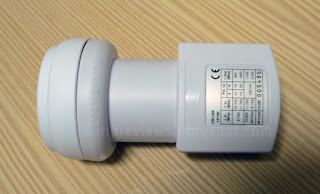Today I will be reviewing two single output Universal Lnb's from Televés, the Televés UNI LNB Ref. 7475 and the Televés UNI LNB Ref. 147160. These are Universal LNB's that cover the 10.7-11.7Ghz and 11.7-12.75Ghz Ku bands. They are LNBF's to be used with offset satellite dishes.
Televés is a well known and well regarded manufacturer of receiving and test equipment from Spain. They are probably more known worldwide for their triple boom UHF DAT antennas. Although Televés manufactures many of their products themselves, I believe these LNB's are sourced from the Far East.
This is the LNB (or LNBF) ref. 7475 model in typical Televés orange color.
 |
| Televés ref. 7475 Universal Single Output LNB. |
And here is the Televés ref. 147160 LNB.
 |
| Televés ref. 147160 Universal Single Output LNB. |
The Televés universal single output LNB ref. 147160 is the same as the ref. 7475 LNB. The only difference is the color (white instead of orange). The label on the 147160 model states the LNB has a consumption of 200mA, but this is wrong! Consumption is 90mA maximum for both models. Both models have a 40mm neck and allow for some adjustment of the focus point on the dish. They come with multilingual installation instructions and spec sheet.
The LNB casing is held with hex screws and is sealed with silicon. Here we can see the usual two local oscillator frequency adjustment screws.
Bellow is a tear-down photo showing the internals of the Televés ref. 7475 LNB. Like most low price LNB's, the first stage amplification uses the common NEC NE3503M04 HJ-FET transistor, identified by the V75 marking. This transistor has an typical NF of 0.45dB @ 12 Ghz. Televés claims an NF (Noise Figure) of 0.5dB for this lnb.
Televés claims a maximum phase noise of -75 dBc/Hz @10Khz. This is not a "stellar" value as many LNB's claim -80 dBc/Hz @10Khz. But we know anyone can claim whatever they want and the reality is quite different!
Televés states a typical gain of only 51dB. This is a lower than usual gain. Most lnb's have a minimum gain of 55 dB or more. Probably the gain figure is also wrong. Note: Televés now sell the 7475 LNB with a stated gain of 58 dB.
Voltage regulation, bias, polarization and band switching is done by the big SSOP-20 package UTC L8211L IC.
Build quality is good, but not perfect. In both lnb's solder flux residue can bee seen in the antenna probes solder joints. Although this is unlikely to have a significant impact on performance, no solder flux should remain in the pcb.
 |
| Televés ref. 7475 Universal Single LNB. |
And this image shows the internals of the Televés ref. 147160 LNB.
 |
| Televés ref. 147160 Universal Single LNB. |
As we can see, the Televés ref. 147160 is exactly the same LNB as the Televés ref. 7475.
Tests
The despite the modest specifications, the Televés ref. 7475 and Televés ref. 147160 perform well, not favouring a particular part of the 10.7 to 12.75Ghz Ku band. Despite using traditional DRO technology this LNB has good frequency stability and is adequate for all but the very low symbol rate broadcasts.
Gain is similar to other tested Universal Lnb's, so probably around 57-58 dB, not the claimed low 51 dB.
Televés claim an NF of only 0.5 dB, while most brands claim 0.3 NF, 0.2 NF or even 0.1 NF. As I have written before, it is simply is not possible to reach such low NF values under normal working conditions. The best available transistors have 0.3 dB NF, at best! So, even 0.3 dB NF claims are unreal, and the Televés 0.5 NF claim is much closer to the real NF.
Televés say low NF is not the only important spec in an good LNB, but also how well it copes with a wide range of signal strengths from the satellite and that the Ref. 7475 copes well in such situations. Since reception conditions for a particular satellite vary from country to country (or even inside the same country) and with different size dishes, it is not easy to verify this claim. However, I agree with the statement from Televés stating that low NF is not the only important spec in an good LNB, but also how well it copes with a wide range of signal strengths.
Note: Televés now sells the ref. 7475 LNB with a claimed NF of 0.3 dB.
Gain is similar to other tested Universal Lnb's, so probably around 57-58 dB, not the claimed low 51 dB.
Televés claim an NF of only 0.5 dB, while most brands claim 0.3 NF, 0.2 NF or even 0.1 NF. As I have written before, it is simply is not possible to reach such low NF values under normal working conditions. The best available transistors have 0.3 dB NF, at best! So, even 0.3 dB NF claims are unreal, and the Televés 0.5 NF claim is much closer to the real NF.
Televés say low NF is not the only important spec in an good LNB, but also how well it copes with a wide range of signal strengths from the satellite and that the Ref. 7475 copes well in such situations. Since reception conditions for a particular satellite vary from country to country (or even inside the same country) and with different size dishes, it is not easy to verify this claim. However, I agree with the statement from Televés stating that low NF is not the only important spec in an good LNB, but also how well it copes with a wide range of signal strengths.
Note: Televés now sells the ref. 7475 LNB with a claimed NF of 0.3 dB.
Download Televés ref. 7475 LNB specifications here (current version).
Download the NEC NE3503M04 N-Channel HJ-FET transistor datasheet here.



